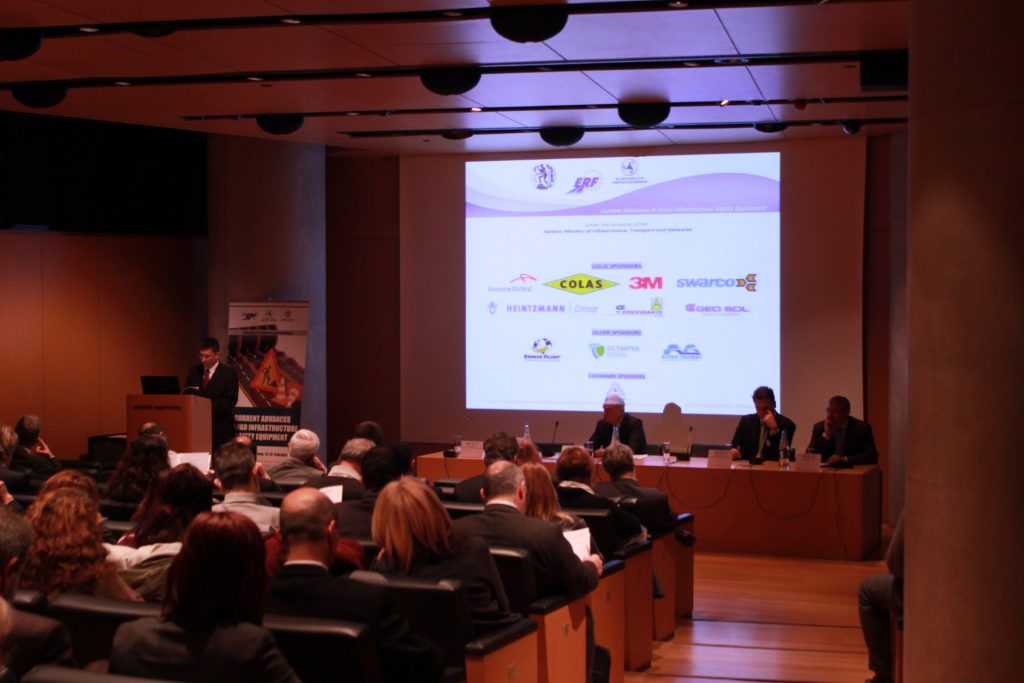19 February 2015 | Athens, Greece
On 12-13 February, more than 200 road infrastructure safety stakeholders gathered in Athens, Greece to attend the first Technical Conference on ‘Current Advances in Road Infrastructure Safety Equipment’.
Co-organised by the European Union Road Federation (ERF), the National Technical University of Athens (NTUA) and the Hellenic Institute of Transportation Engineers (HITE), the conference was dedicated to providing Road Authorities and Operators, Transportation Planners, Engineers and Road Safety Experts with an overview of European policies, legislation, technical norms and good practices in the field of roadinfrastructure safety equipment, in view of the re-launching of important motorways construction projects to complete the Greek TEN-T.
Following the opening remarks by the co-organisers, the first session was devoted to ‘European and National Policies’ where presenters focused on the policy challenges in terms of infrastructure. There was a consensus over the need to do more for the protection of vulnerable road users (in particular, motorcyclists) on motorways as well as the need to ensure that road marking remain visible in order to maximise the safety benefit from the introduction of Advanced Drivers Assistance Systems in the intelligent vehicle.
Subsequently, the conference focused on the essential role of road restraint systems as a means of improving safety on Europe’s roads. The introduction of the EN 1317 and CE marking for safety barriers represents an opportunity for Greek authorities, yet challenges remain. In particular, authorities need to ensure the authenticity of CE certificates in order to ensure that all products placed on the road are properly tested according to hEN 1317-5. In addition, when selecting products, authorities need to also take into account maintenance considerations as a means of maximising public investment.
The 2nd day of the conference was dedicated to the topics of horizontal and vertical signage, work zones and road maintenance. Road marking and traffic signs are one of the most cost-effective safety measures available to policymakers and as such, it is essential to ensure that they remain visible to satisfy both the needs of an increasingly ageing driver population and ensure the potential safety gains from the introduction of Lane Departure Warning and Traffic Sign Recognition Systems in the intelligent vehicle. With respect to work zones, they remain an area where significant safety gains can be achieved and as such, participants were encouraged to explore available solutions for enhancing their performance. Last but not least, and in view of limited public resources, it is imperative to consider ways of maintaining the skid resistance of roads in order to avoid run-accidents.
In their conclusions, ERF General Director, Mr Nicodème and NTUA Prof. Yannis both highlighted the essential role of road infrastructure as a means of improving road safety with immediate effect. In view of cut-backs in road maintenance budgets in recent years, both speakers talked about the necessity to reverse this trend to ensure that Europe’s road can continue to serve citizens and businesses in their daily lives.
The Technical Conference was accompanied by an exhibition, where leading safety companies in the field had the opportunity to display their solutions.
Below you can find:
-
Safer, Smarter Roads Discussed at the 25th Belgian Road Congress
October 10, 2025 -
ERF calls for Smarter, Safer Road Work Zones at Bologna Forum
October 9, 2025

